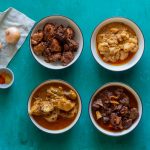The simplest Pakistani salan recipe (with multiple variations using the same ingredients)
Step by step guide to making the simplest Pakistan salan. All you need is ginger garlic paste, onions, powdered spices and your favorite meat cut. The best part about this recipe is how simple and versatile it is – with the exact same ingredients, you can create multiple salan variations such as bhuna chicken, chicken ka salan, chicken ka shorba and mutton (goat meat) ka salan.
Servings: 4 people
Calories: 300kcal
Ingredients
- ¼ cup oil
- 1 medium / 120 grams onion, sliced see note 1 for other types of onions
- 500 gram meat (I prefer to use skinless, bone-in chicken curry pieces) see note 2 for other meat options
- 1 teaspoon ginger garlic paste
- 1 teaspoon coriander powder
- ¼ teaspoon turmeric powder
- ½ teaspoon red chili powder
- 1 teaspoon salt
- 2 tablespoons yoghurt if using
- Water as needed
Instructions
- Heat oil in a medium sized pot. This can be stainless steel, enameled cast iron, or aluminum pot. It is also possible to use a pressure cooker (or multicooker).
- Add the sliced onions, and fry till they turn golden brown. Keep stirring regularly. The darker the color of the onions, the richer the color of the salan / gravy. However, be careful of burning the onions.
- Once the onions have been browned, add the meat. Cook the meat on medium heat for a few minutes till it changes color and the water dries off. This step ensures that any possible smell (or heek) goes away.
- Then add ginger garlic paste, as well as the powdered spices (coriander powder, red chili powder and turmeric powder), and salt. The spices need to be cooked on medium heat so that they release their flavor, and the raw taste dissipates. This process will take about 1 – 2 minutes. In case the spices are burning, add a splash of water.
- Once the spices have been cooked, add yoghurt (if using) and saute for another 2 minutes.
- Once the salan masala is ready, add water as required. The amount of water you add also depends on the meat and method of cooking you are using.
- Depending on the water you add, this will be the type of salan that will be made:- Bhuna style chicken / gosht: If you add only a few tablespoons of water or yoghurt then your salan will be on the dry side, and will be called dry or bhuna style.- Salan: If you add 1 cup of water then it will be what is called a salan consistency. Think gravy like, but not too liquid.- Shorba: If you add about 1 ½ - 2 cups (or more) of water, then the gravy will be on the thinner side like a broth.If you are making a salan using red meat (goat meat, lamb or beef) you will need to add extra water, as the water will evaporate during cooking. If you are using a pressure cooker, you will need to reduce the amount of water as it won’t evaporate.
- Bring the salan to a boil, and then turn heat to low partially covering the pot and cook the meat till it is tender . Boneless chicken will take around 30 minutes, bone-in chicken will take around 45 minutes. Beef, goat meat and lamb will take longer.
- Once the meat is tender, taste and add salt if needed. You can also adjust the gravy quantity – add water, or turn the heat to high to evaporate some of the gravy.
- Salan can be served with a South Asian style bread such as roti, chapati, naan or paratha. I personally prefer to have salan with roti or chapati. It can also be served with plain rice or zeera rice.
Notes
1. Sliced is my favorite way of cutting onions, as they caramelize nicely and dissolve best in the salan. Other than sliced, the following types of onion cuts can be used:
- Diced: Diced onions can also be used, but in my opinion, they take more time to caramelize.
- Onion Paste: Onions can be blended with water into a paste, and used. The benefit of using onion paste is that the salan is on the smoother side, but the color is less golden brown.
- Fried onions / Barista: Crispy fried onions (also known as barista) can be used instead of fresh ones. This is a convenient option that saves a lot of the frying time. It’s possible to make these at home, or you can purchase from the supermarket. One medium onion is about 100 grams (½ cup) of crispy fried onions. To use fried onions, heat a tablespoon of oil, and fry the onions for 1 – 2 minutes and then proceed with the recipe.
Nutrition
Calories: 300kcal
Tried this Recipe? Tag me Today!Mention @MirchiTales or tag #mirchitales!
